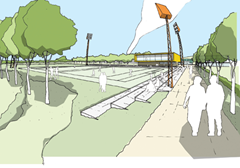Transforming Lisanelly
 An overview of Northern Ireland’s largest school building project.
An overview of Northern Ireland’s largest school building project.
Supporters of the Lisanelly shared educational campus see it as a ‘swords to ploughshares’ project and a once-in-a- lifetime opportunity for Omagh.
The rationale for the £100 million scheme is based on the need to replace or substantially renovate schools in the town, its relatively good community relations, and the availability of the former military base.
That area has been vacant since 2007 and was gifted to the Executive through last year’s Hillsborough Castle Agreement. The total site is 139 acres: 118 at Lisanelly itself and 21 at the adjacent St Lucia site.
Up to six schools could be located on the site, retaining their ethos and each having its own core building. However, pupils will increasingly be educated in shared classes as they move through the key stages of the curriculum.
In particular, there would be four shared
facilities, which standalone schools could not create on their own:
• a school of performance (music and drama);
• a school of making (art and design);
• a school of activity (sport); and
• an ecology field centre.
The project would also be a major step forward for shared education in the Omagh area. Integrated education is limited in the Western area. Just eight out of 246 schools from the formal integrated sector although some maintained and controlled schools also have shared enrolments.
Significantly, it has the backing of Protestant and Catholic churches. Its working group is jointly chaired by Rev Robert Herron (Trinity Presbyterian Church) and Monsignor Joseph Donnelly (Drumragh parish). Both men minister in the town and Rev Herron also chairs the Western Education and Library Board.
 Five schools are prepared to move to the new site:
Five schools are prepared to move to the new site:
• Arvalee Special School;
• Omagh Academy;
• Omagh CBS Grammar School;
• Omagh High School; and
• Sacred Heart College.
Phase one is likely to include Arvalee, Omagh High and Sacred Heart.
Another school, Loreto Grammar, was to be relocated to Lisanelly but is currently in a legal dispute with the Department of Education. Loreto was pledged £14.6 million for new buildings by direct rule Education Minister Barry Gardiner in April 2010. The school anticipated a new build by 2010, which would have been delivered through a public-private partnership.
When the Lisanelly site became available, the Department of Education instead concentrated on bringing schools together in the shared campus. The building plans of eight schools, including Loreto, were rejected for not complying with departmental policy.
The High Court found in favour of Loreto on 25 March this year, when Mr Justice McCloskey described the conduct of Caitríona Ruane and her department as an “abuse of power”. The governors’ expectations, in his view, were not properly considered.
 An appeal was subsequently lodged by the Department of Education and was being heard in the Court of Appeal at the time of going to press.
An appeal was subsequently lodged by the Department of Education and was being heard in the Court of Appeal at the time of going to press.
Caitríona Ruane strongly backed the project and John O’Dowd is also supportive. O’Dowd has described it as “a template for shared education that could potentially be implemented in many other areas.”
Overall, the capital budget for schools has been cut from £927.4 million over 2008-2011 to £489.2 million over 2011-2015. Lisanelly is the largest project in the system and the Minister plans to keep it at the top of the list.
The steering group first met in April 2009 and an exemplar design team led by Bovis Lend Lease was appointed in March 2010.
A planning application is due to be submitted in November with a decision on outline planning permission expected by summer 2012. A subsequent reserved matters application would be submitted in mid-2012.
Each building will take 12-18 months to construct. The first construction phase is expected to start in January 2013 with the first schools hoping to be on site by September 2015.





